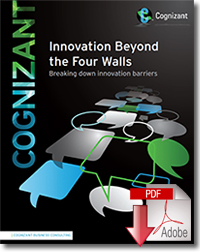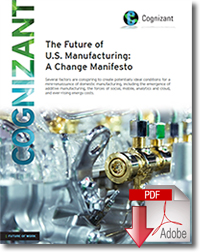The Supply Chain is Dead; Long Live the Value Web

It's all about the Code Halos, baby. To better meet and react to hyper-active market demand, companies need to move from the hard-coded supply chains to a flexible, demand-driven value webs.
Most companies realize it’s foolhardy to try and “do it all,” particularly in a globalized, digitized and highly informed world.
While the daily operations that make providing goods and services possible - from sourcing of raw materials to post-delivery date - were once understood as the “supply” or “value chain,” those terms are no longer relevant.
Like the end of linear shopping, the value chain today is probably better described as a “value web,” one where suppliers are structured and called upon in flexible, modular and amorphous ways to meet projected business demand.
For instance, many previous in-house activities are now performed by external providers from all over the world to provide speed, quality and cost advantages. In some cases, the lines of who does what have even been blurred (i.e., 3D printing may soon turn retailers into pseudo-manufacturers).
Meanwhile, processes that traditionally took place on-site - order management, medical and clinical trials, digital assets - are moving to the cloud. And with better access to real-time data and more fluid means of collaborating, upstream and downstream partners are working more closely than ever before.
As for customers - formerly the last link in the chain - they’re now playing a leading role in the creation of value web, thanks to their powerful and more informed digital footprints - or Code Halos™ as we call them - that convey deep insights on preferred products, services, as well as ways of interacting and transacting, across digital channels.
As such, forward-thinking companies are inhaling and analyzing every customer click, tweet, like and post to formulate global and virtualized supply strategies while developing personalized products and services. These companies have moved beyond traditional business intelligence that primarily illuminate historic performance.
They are moving from insights to foresights by embracing new predictive analytics tools built around the emerging SMAC Stack™ (social, mobile, analytics and cloud).
Here’s how your organization can do the same and quickly adapt to changing market forces:
- Decide what needs fixin’. To devise a more flexible value chain, you’ll need to identify the enterprise’s pain points first. The three most common are time to market, cost reduction and product innovation. Whether the goal is same-day delivery (thanks, Amazon, eBay and other born-digital companies!), lower costs of goods, freight and inventory or crowdsourcing (download: Innovation Beyond the Four Walls), you’ll do well to follow those who are welcoming customers into the value web, namely Starbucks, Pepsi and Procter & Gamble. (Companies to Admire).
- Think strategically, not operationally, when outsourcing. Learning how to collect and analyze customer data from Code Halos is where companies need to apply more resources. They cannot do this if they are preoccupied with everything else, from soup to nuts. Smart companies understand this and offload non-differentiating functions accordingly to trusted partners. And not just call centers and IT services; strategic outsourcing now includes elements of product development, marketing, sales, distribution and fulfillment, human resources, finance and legal.
Pinpointing Value Chain Priorities
- Establishing technology and cultural readiness. That includes investing in SMAC Stack infrastructure as much as gaining inter-department buy-in and fluid communication between ERP, sales, inventory and operation teams. For instance, linking a retailer’s point of sale data with back-end planning and order management provides insights into what is actually happening vs. relying on forecasts. All told, establishing technology and cultural readiness will be your biggest barrier to creating a nimble company and competitive advantage.
Agility: The Killer App
An example of the growing need for value chain agility is the trend among manufacturers to shift their global sourcing strategies from a “low-cost country sourcing” perspective to one based on “best-cost country sourcing.” While many companies moved their manufacturing operations offshore to lower their labor costs, the revised thinking in some cases is to move supply closer to areas of high demand.
Lenovo, for instance, built a new manufacturing facility in North Carolina in 2013 to improve the efficiency and reliability of product delivery in the North American market. General Electric relocated some of its appliance manufacturing from China to Kentucky to be closer to demand. These strategic decisions pointless to a generalized retrenching on domestic soil and more a desire to flexibly change what gets done and where, as market conditions and customer demands evolve. (download: The Future of U.S. Manufacturing: A Change Manifesto)
For example, when the 2008 tsunami disrupted the Japanese supply of car parts, U.S. and European automakers boosted production to flood the market and give consumers immediate choices as an alternative to waiting. Or the tile manufacturer we worked with that boosted revenues by 20% after moving from retail to a direct-to-consumer model using our SMAC-based analysis of current vs. future demand.
In an age of uncertainty and constant change - particularly the changes wrought by unrelenting digitization - companies can no longer function via a linear set of interlocked processes.
The business leaders of tomorrow will quickly shift value chain strategies to optimize speed, quality and cost to take advantage of global market opportunities.
Such flexibility is possible when companies look at supply chains differently - as value webs - with an eye toward disaggregating functions and focusing less on “who” is doing the work “where” and more on the how the collective actions of all participants drive improved performance in line with ever-changing market requirements.
Source: Cognizant Perspectives
Article Topics
Cognizant News & Resources
Blockchain’s Smart Contracts Will Blockchain Revolutionize Supply Chains? Raffaello D’Andrea on the Future of Robotics The Astounding Athletic Power of Quadcopter Drones The Robot and I: How New Digital Technologies Are Making Smart People and Businesses Smarter No Amazon Drone Delivery Under New FAA Rules U.S. Attacks on Drone Use May Trigger Trouble for Amazon More CognizantLatest in Technology
Biden Gives Samsung $6.4 Billion For Texas Semiconductor Plants Apple Overtaken as World’s Largest Phone Seller Walmart Unleashes Autonomous Lift Trucks at Four High-Tech DCs Talking Supply Chain: Procurement and the AI revolution 80% of Companies Still Unsure How to Best Leverage AI, Study Finds Supply Chain Stability Index: “Tremendous Improvement” in 2023 AI Not a Priority for Retailers and CPG Companies More Technology
















